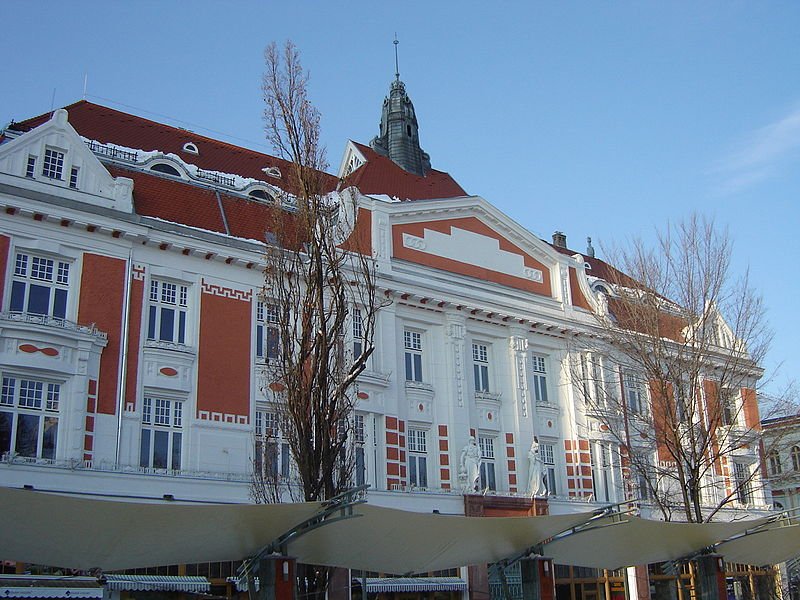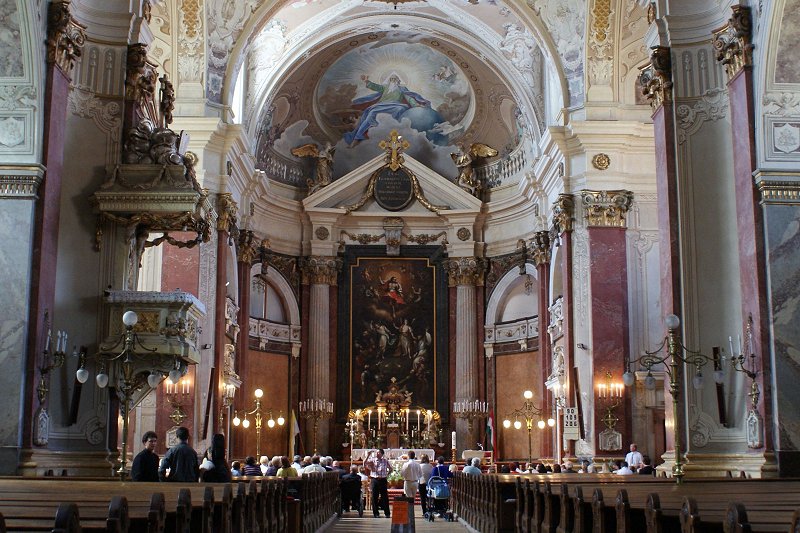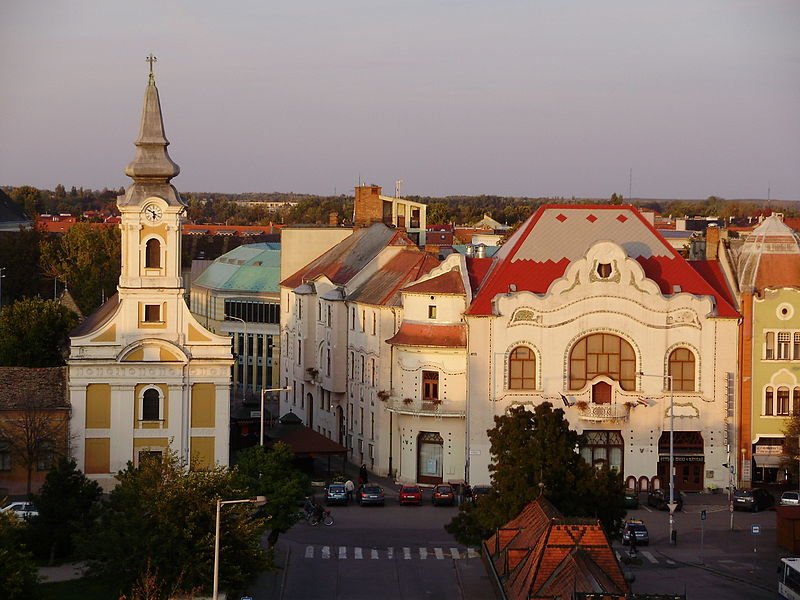 The Press House, Kecskemet
The Press House, KecskemetSource: https://commons.wikimedia.org/wiki/File:Sajt%C3%B3h%C3%A1z_Kecskem%C3%A9t.JPG
Author: Nbcee

Kecskemét is a city on the central part of Hungary. Often regarded as the Garden of Hungary, it is at the center of the agricultural heartland of the country. Kecskemét covers 321.36 sq km (124.1 sq mi) and has a population of 113,000 (2011 estimate). It is the 8th biggest city in Hungary.
The name Kecskemét means "goat". The soil here is essentially sandy. Centuries of pasturing and overgrazing have further denuded the land, creating sand dunes. The area around Kecskemét have been undergoi8ng afforestation and the planting of fruit trees and vines to stabilize the soil again.
The climate of Kecskemét can be described as continental. July is the warmest month, with average temperatures of 20.9°C. Coldest is the coldest month, when the average temperature drops to -1.9°C.
Human habitation in the Kecskemét area goes back five thousand years. The earliest settlement is believed to have been established by the Sarmatian culture in the 1st century BC. It was an ancient village called Partiskum. Nothing much is known between then and the 13th century, when seven villages have been formed. They were however totally destroyed during the Mongol invasion.
 Great Church of Kecskemet
Great Church of KecskemetSource: https://commons.wikimedia.org/wiki/File:R._k._pl%C3%A9b%C3%A1nia_(2234._sz%C3%A1m%C3%BA_m%C5%B1eml%C3%A9k).jpg
Author: tourista

The town of Kecskemét was first mentioned in 1368. Under the rule of the Ottoman Empire, it gained a degree of autonomy. When the Habsburg Empire took over, the region was encouoraged to develop its agriculture.
As with many cities in Hungary, Kecskemét suffered from the Great Depression and the Second World War, after which it remained behind the Iron Curtain until the collapse of the Soviet Union. Since then, development in the Kecskemét area has gradually accelerated. In 2008, German auto manufacturer Daimler put in place plans to build one of the biggest Mercedes-Benz manufacturing plant in the city, giving the local economy a hefty boost.
 Former Craftsman House, now Youth Center, in Kecskemet
Former Craftsman House, now Youth Center, in KecskemetSource: https://commons.wikimedia.org/wiki/File:Ifj%C3%BAs%C3%A1gi_Otthon_2.jpg
Author: Cséplő Gábor

Visiting Kecskemét
If you arrive at Budapest Airport, you can take a 60-minute train ride to Kecskemét from the newly opened Ferihegy Train Station, located near Terminal 1 of the airport.There are also trains from Budapest to Kecskemét. They take an hour and twenty minutes to make the journey.
Places of Interest in Kesckem&aeacute;t
- Great Catholic Church (Nagytemplom)
This gigantic church, built in 1772-96, has a spire reaching to 73 m (240 ft). The exterior was done in the Baroque style. - Holy Trinity Monument
Memorial located in front of the József Katona Theater. It commemorates the passing out of a plague in 1742. - Hungarian Photography Museum (Magyar Fotográfiai M&úzeum)
Museum housed in an 18th century mansion that displays the works of every major Hungarian photographer. It also hosts temporary exhibits by international artists. It has one of the best bookshops on photography. - József Katona Theater
Neo-Baroque theater built in 1896 and named in honor of Kecskemét's acclaimed playwright. - Kossuth tér
The historic quarter of Kecskemét with many important buildings including the Lutheran Church, Synagogue, Ornamental Palace, Calvinist New College, St Michael's Church, Calvinist Church, Town Hall and Great Catholic Church. - Museum of Applied Folk Art (Népi Iparművészeti Múzeum)
Housed in a 200-year-old brewery, this museum is devoted to folk art encompassing woodcarving, weaving, pottery, embroidery and other fields. - Museum of Hungarian Naïve Art (Magyar Naiv Müvészek Múzeuma)
Museum exhibiting works by early Naïve and contemporary artists. - Museum of Medicinal and Pharmaceutical History (Orvos és Gyógyszerészettöténeti Kiállitás)
A small museum whose most interesting feature is the building itself, which was originally a pharmacy. - Ornamental Palace (Cifra Palota)
Historic building in the Secessionist style completed in 1902, it today houses an art gallery exhibiting some 10,000 works. - Piarist Church & School (Piarista Templom & Rendház)
Church of a progressive, scientific Catholic order founded in Rome in 1597. The church was built in the Baroque style in 1729-65. The statue of its founder St Joseph Calasanctius is in front of the church, along with that of the Virgin Mary, St István and St László. - Szórakaténusz Toy Museum and Workshop (Szórakaténusx Játékmúzeum és Műhely)
Located next to the Museum of Hungarian Naíve Art, this museum displays Hungarian toys from the 18th century to present day. - Zwack Fruit Brandy Distillery and Exhibition
Visitor center for Hungary's famous plum brandy providing an insight into the manufacture of the product.
 Latest updates on Penang Travel Tips
Latest updates on Penang Travel Tips
Songs about Penang
About this website

Hello and thanks for reading this page. My name is Timothy and my hobby is in describing places so that I can share the information with the general public. My website has become the go to site for a lot of people including students, teachers, journalists, etc. whenever they seek information on places, particularly those in Malaysia and Singapore. I have been doing this since 5 January 2003, for over twenty years already. You can read about me at Discover Timothy. By now I have compiled information on thousands of places, mostly in Peninsular Malaysia and Singapore, and I continue to add more almost every day. My goal is to describe every street in every town in Malaysia and Singapore.
Copyright © 2003-2024 Timothy Tye. All Rights Reserved.


 Go Back
Go Back